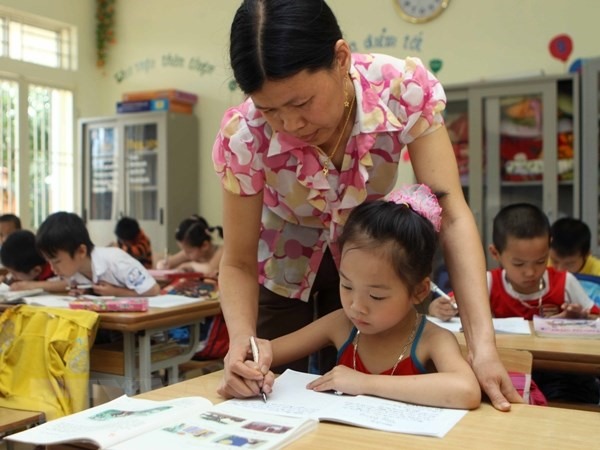

Education minister Phùng Xuân Nhạ on Monday stood before a committee hearing at the National Assembly to explain a shortage of thousands of teachers nationwide.
 |
| The number of teachers at kindergartens and schools was more than 1.16 million as of August 15, 2018, of which nearly 859,000 teachers work in public institutions while more than 23,600 teach in non-public sector. — VNA/VNS Photo |
HÀ NỘI — Education minister Phùng Xuân Nhạ on Monday stood before a committee hearing at the National Assembly to explain a shortage of thousands of teachers nationwide.
The hearing was chaired by the Committee for Culture, Education, Youth, Adolescents and Children to look into the responsibility of the Ministry of Education and Training in the recruitment process.
A severe lack of teachers in recent years has forced a number of localities to illegally hire more teachers to meet the demand.
In a report by the education minister Nhạ, the number of teachers at kindergartens and schools was more than 1.16 million as of August 15, 2018, of which nearly 859,000 teachers work in public institutions while more than 23,600 teach in non-public sector.
Việt Nam was currently short of just under 76,000 teachers to meet the ever increasing demand, Nhạ said. Shortage of kindergarten teachers was the most severe as more than 43,000 were still needed across the country. It was estimated that primary, secondary and high schools lacked some 19,000, 10,000 and 3,100 teachers respectively.
Secondary schools, however, suffered from teacher shortage and unbalance at the same time, the minister said.
The teacher unbalance occurred between subjects traditionally deemed more important like Maths or Literature and those deemed less important like Art or Music, or between educational institutions or cities and provinces that the authorities failed to manage and adjust.
Secondary schools in Việt Nam were reported to to need more than 10,000 teachers but also had some 12,100 surplus.
The nationwide teacher shortage came from various reasons, the minister told the committee hearing.
“It could be due to changes in school/class size after a school restructuring or a population increase in central areas, big cities or industrial zones,” he said.
“At kindergarten level, a programme to make education for five-year-old children universal also strained the teacher supply while a big jump in the number of children born in 2012 (11 localities reported ‘abnormal’ increase of student size) put pressure on primary schools this year.”
2012 was the Year of Dragon, which was believed by Vietnamese people to be one of the best years to have children as they will be destined to have a prosper life in the future.
Another reason for the severe teacher shortage resulted from the Government’s rigid policy to downsize public employees since 2015, which only allowed localities to recruit half of the number of teachers they lost – mostly from retirement.
That left many localities, for example Phú Yên, Quảng Ngãi, Đắk Lắk and Hà Nội, with no choice but to "break the law" and sign illegal contracts with kindergarten and primary teachers for the sake of the students.
Nhạ said the education ministry was collaborating with the Ministry of Home Affairs – which oversees the recruitment of public employees – to help localities collect data on their teachers, population and students from 2015 to 2018.
The education ministry will work out solutions based on such reports to resolve the teacher shortage situation and submit them to Prime Minister Nguyễn Xuân Phúc for approval as soon as possible, he added. — VNS




